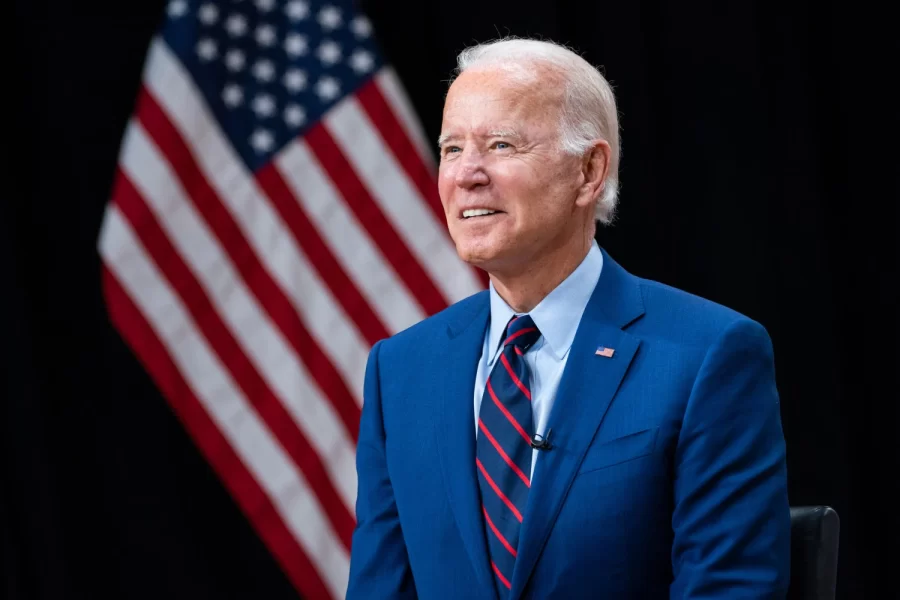The Biden Administration executes a student loan forgiveness plan
The plan outlines federal student debt cancellation, currently amounting to $32 billion
President Biden announced in late August that he would cancel up to $10,000 in student loan debt for certain borrowers.
September 8, 2022
On Wednesday, Aug. 24, the Biden Administration announced a three-part plan to address student loan debt. To mitigate the financial burden caused by the COVID-19 pandemic, President Joe Biden and his team aim to not only significantly decrease monthly loan payments but also to provide debt cancellation for current students and alumni who received federal loans before June 30, 2022.
Through the expansion of current debt forgiveness programs, the Biden administration has canceled almost $32 billion of the $1.6 trillion student loan borrowers collectively owe the federal government. In efforts to increase this number, Biden and the Department of Education have extended the pause on federal student loan payments and implemented a debt forgiveness plan. The hold on loan payments has been extended through December 31, 2022, with payments resuming on January 1, 2023. Federal student loan borrowers who make less than $125,000 annually are eligible for up to $10,000 of loan forgiveness. Households who earn less than $250,000 also qualify for this sum.
Despite the promise of loan forgiveness, Wake Forest alumni Tommy Taylor expressed doubt about the effectiveness of Biden’s plan.
“I should say up front that I don’t personally have any student loans, but from the outside, to me this seems like an attempt to drum up excitement going into the midterms,” Taylor said. “The administration promised movement on this during the campaign, and they want to be able to claim progress going into the election. Obviously, a lot of people will get relief from their loans, but the plan doesn’t really address the systemic problems that created this crisis in the first place, that is — in my opinion — the cultural obsession with higher education, the high interest rates on these loans that prevent people from making progress on them, the out-of-control tuition increases — which Wake Forest is certainly guilty of— and the fact that it’s basically impossible to declare bankruptcy based on student loans.”
Taylor continued: “Until you deal with those and I’m sure other issues people will continue to end up in the same position those people whose loans are being forgiven are in.”
Low-income students and borrowers that are out of school may be significantly affected by Biden’s debt cancellation plan. Those who meet the income criteria and have received a Pell grant are eligible to receive up to $20,000 in loan forgiveness. According to the Department of Education’s Federal Student Aid Office, Pell grants are awarded to students who “display exceptional financial need and have not earned a bachelor’s, graduate or professional degree”. Alongside low-income students and alumni, some first-generation students will benefit from the $20,000 debt cancellation.
Carol Torres is the adviser of First in the Forest, a resource program for first-generation students at Wake Forest. When asked about the effect Biden’s plan will have on first-generation students, Torres explained how the plan may bring peace of mind to students and graduates.
“With this plan in place, hopefully students can graduate and not have to worry about compromising basic living needs, such as being able to afford food or housing, in order to pay off their student loans,” Torres said.
Because the Department of Education already has income information, almost eight million borrowers may automatically receive loan forgiveness. For those who need to send their income information to the Department of Education or are unsure if the department has their data, an application will be launched in early October and will close on Dec. 31. Applicants can expect to receive loan forgiveness within four to six weeks. Those whose loan balance exceeds their forgiveness amount may be eligible for a repayment plan.
Alongside debt relief, the Biden administration plans to implement a new repayment plan that will cut monthly loan payments in half. As opposed to the current 10%, borrowers may pay up to 5% of their discretionary income each month. Discretionary income is defined as the difference between a household’s annual income and 150% of the poverty guidelines. Eligibility for this new repayment plan has not been determined. Additionally, Biden aims to forgive loan balances after 10 years of payments for borrowers with original loan balances of $12,000 or less. This timeline is in contrast to the current 20-year mark.
The final facet of the President’s student debt plan focuses on controlling higher education costs.
Biden signed a significant increase to the maximum Pell Grant through the American Rescue Plan. Almost $40 billion was given to higher education institutions, which is the largest increase to the Pell Grant in more than a decade. The Department of Education is taking action by releasing an annual watch list of college programs with high debt levels. This publication will provide information to incoming students regarding the debt they could potentially incur. Through public access to information and new enforcement units in the Office of Federal Student Aid, the Biden Administration and the Department of Education can keep institutions accountable in their pricing.
“I personally think this is a great start toward making higher education equitable for all students,” Torres said. “At one point in time receiving a higher education was obtainable for the average American with a minimum wage job, and now it’s an investment with a very high cost — monetarily and beyond.”
More information about Biden’s student debt plan and individual eligibility for loan forgiveness can be found here.













